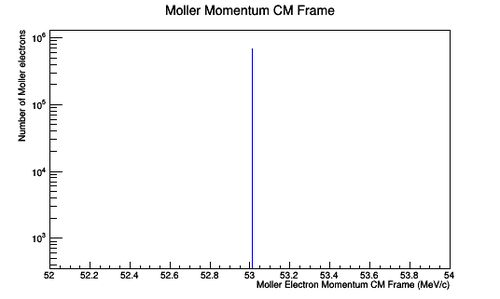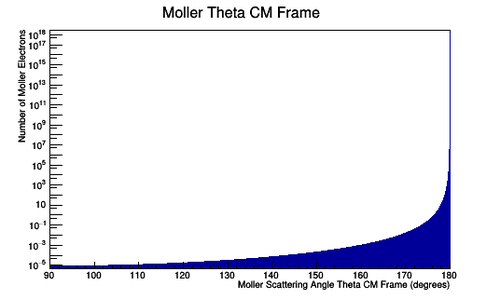Difference between revisions of "DC hits to Moller XSection"
Jump to navigation
Jump to search
| (42 intermediate revisions by 2 users not shown) | |||
| Line 1: | Line 1: | ||
=Verification using LUND and evio files= | =Verification using LUND and evio files= | ||
| − | The LUND files are broken into 1000 events per file to produce manageable GEMC output file sizes. The kinematics of these | + | The LUND files are broken into 1000 events per file to produce manageable GEMC output file sizes. The kinematics of these Moller events is shown fin Figure 1. |
| − | |||
| − | + | [[File:MolMomCM_11_2.png |thumb | border | center |500 px |alt=Moller Momentum Center of Mass Frame |'''Figure 1a:''' A plot of Moller electron momentum in the center of mass frame.]][[File:MolTheteaCM_full.png |thumb | border | center |500 px |alt=Moller Theta Center of Mass |'''Figure 1b:'''A plot of Moller electron scattering angle theta in the center of mass frame.]] | |
| − | = | + | =[[DV_RunGroupC_Moller#DC_hits_to_Moller_XSection|back]]= |
| − | |||
| − | |||
| − | |||
| − | [[ | ||
| − | |||
| − | |||
| − | |||
| − | |||
| − | |||
| − | |||
| − | |||
| − | |||
| − | |||
| − | |||
| − | |||
| − | |||
| − | |||
| − | |||
| − | |||
| − | |||
| − | |||
| − | |||
| − | |||
| − | |||
| − | |||
| − | |||
| − | |||
| − | |||
| − | |||
| − | |||
| − | |||
| − | |||
| − | |||
| − | |||
| − | |||
| − | |||
| − | |||
| − | |||
| − | |||
| − | |||
| − | |||
| − | |||
| − | |||
| − | |||
| − | |||
| − | |||
| − | |||
| − | |||
| − | |||
| − | |||
| − | |||
| − | |||
| − | |||
| − | |||
| − | |||
| − | |||
| − | |||
| − | |||
| − | |||
| − | |||
| − | |||
| − | |||
| − | |||
| − | |||
| − | |||
| − | |||
| − | |||
| − | |||
| − | |||
| − | |||
| − | |||
| − | |||
| − | |||
| − | |||
| − | |||
| − | |||
| − | |||
| − | |||
| − | |||
| − | |||
| − | |||
| − | |||
| − | |||
| − | |||
| − | |||
| − | |||
| − | |||
| − | |||
| − | |||
| − | |||
| − | |||
| − | |||
| − | |||
| − | |||
| − | |||
| − | |||
| − | |||
| − | |||
| − | |||
| − | |||
| − | |||
| − | |||
| − | |||
| − | |||
| − | |||
| − | |||
| − | |||
| − | |||
| − | |||
| − | |||
| − | |||
| − | |||
| − | |||
| − | |||
| − | |||
| − | |||
| − | |||
| − | |||
| − | |||
| − | |||
| − | |||
| − | |||
| − | |||
| − | |||
| − | |||
| − | |||
| − | |||
| − | |||
| − | |||
| − | |||
| − | |||
| − | |||
| − | |||
| − | |||
| − | |||
| − | |||
| − | |||
| − | |||
| − | |||
| − | |||
| − | |||
| − | |||
| − | |||
| − | |||
| − | |||
| − | |||
| − | |||
| − | |||
| − | |||
| − | |||
| − | |||
| − | |||
| − | |||
| − | |||
| − | |||
| − | |||
| − | |||
| − | |||
| − | |||
| − | |||
| − | |||
| − | |||
| − | |||
| − | |||
| − | |||
| − | |||
| − | |||
| − | |||
| − | |||
| − | |||
| − | |||
| − | |||
| − | |||
| − | |||
| − | |||
| − | |||
| − | |||
| − | |||
| − | |||
| − | |||
| − | |||
| − | |||
| − | |||
Latest revision as of 21:52, 27 July 2017
Verification using LUND and evio files
The LUND files are broken into 1000 events per file to produce manageable GEMC output file sizes. The kinematics of these Moller events is shown fin Figure 1.

